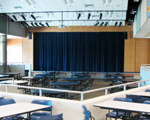It certainly isn’t a new idea… How do we maximize our space and minimize our cost without the loss of function? Surely this is the major driver behind ideas like the gymnatorium or the cafetorium. We’ve all seen them, most likely they were in the schools that we attended. They consist of a stage at one end of the room or tucked away in the corner. So, do these budget savers really work like they are supposed to?
There are multiple answers inside that one little question. First of all, they do an excellent job of multi-tasking and using the allotted space efficiently. Cafeterias are hardly used at night and most auditoria lay empty the vast majority of days. When considering the cost of design and construction on a square foot bases to the amount of time using the space, you can’t beat them. Score one for the cafetorium. Acoustically they are another issue. We have consulted on several projects that are remodels, retrofits, and redesigns involving the gymnatorium and cafetorium. Usually these budget friendly spaces get designed first for their primary use; performance considerations are often relegated to the back of the priority line and hardly considered.
In my opinion this is the downfall of the spaces. I know they certainly aren’t glamorous and on the first budget meeting these spaces get an arbitrary number thrown at them (which is usually cut in half later). Understandably, physics gets in the way of these spaces ever performing like the auditorium at the high school down the street and buying the next bigger and better audio system usually doesn’t help to solve the issues faced by these spaces. As consultants, we’ve found that these spaces can still work for their intended multi-functioned use, even with small budgets.
The key to getting these spaces to perform acoustically is to consider the acoustics very early in the design process. When we are involved early in the design process we can affect things like the room volume and general layout. Although they are often overlooked (acoustically) these key design points can then be further enhanced by the selection of materials and a well designed audio system. All this can still be done with the budget in mind. Early decisions in the room size and shape will affect how much of that expensive acoustical treatment will need to be added later, often saving money.
I certainly don’t mean to imply that we can design a cafetorium that the latest tour of La Boheme would be proud to perform in, but when considering the users, mom and dad still need to be able to see and hear their little stars singing their hearts out; even if they just ate their chicken nuggets in the room 6 hours earlier.
The acoustical engineers at Acoustics By Design have designed numerous Cafetoriums and Gymnatoriums. Click here to see some of our work.
